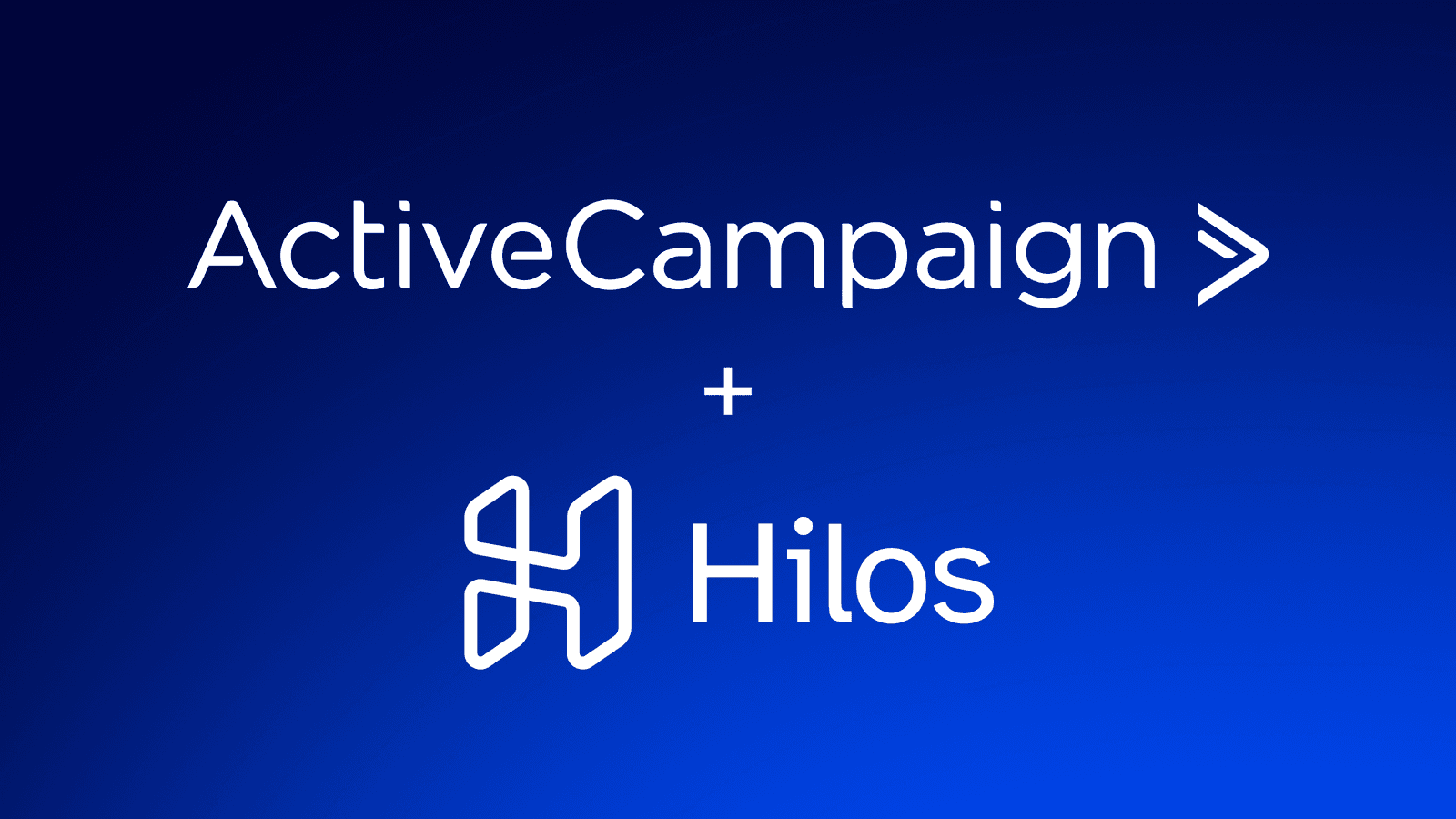You have an important message.
The person it’s for should really hear it.
No. It’s more than that. Your audience shouldn’t just listen to you – they need to listen to you. After all, your business can offer them something that will improve their lives.
You’re sure that they would be interested in what you have to say.
If only they would listen.
Getting people to pay attention to your marketing and messaging is one of the major challenges of running a small business. Getting people to turn into customers based on that messaging is even harder.
Luckily, there are some things you can do to make your messages more interesting.
Psychologists have spent a lot of time and research dollars studying why people do things. A lot of that research feels pretty academic – and you probably don’t care all that much about their statistical analysis or experimental design.
But their results? Their results can help.
Any one of these persuasive techniques in marketing could explode your business.
When you read famous case studies – like the Wistia emails that got 350% more paid conversions or the Crazy Egg home page that boosted conversions by 360% – these are the techniques being used.
Where can you use them? In your emails. On social media. For your website. On your landing pages.
Any time you talk to your audience—especially any time you drive them to a call to action—you have an opportunity to be more persuasive.
The best persuasion tactics from social psychology, and when you mix them with marketing experience you have a powerful way to improve conversion.
Here are 23 powerful persuasion techniques:
- “Even if” technique
- “Because...”
- Unity
- Anticipation
- Reasoning by analogy
- The curiosity gap
- Foot-in-the-door technique
- Door-in-the-face technique
- Reciprocity
- Liking
- Scarcity
- Authority
- Commitment & Consistency
- Social proof
- Urgency
- Loss aversion
- Future pacing
- The Zeigarnik effect
- High-activation emotions
- “Purple Cows”
- The word "you"
- Anchoring and adjustment
- Belief matching
Try it now, for free
Persuasion Techniques for Marketing
1. “Even If” technique
Everyone believes that they are special. Everyone believes that they are above average.
This idea is so well supported in psychology that it has half a dozen names. Illusory superiority, the above-average effect, the superiority bias, the leniency error, and the primus inter pares effect all describe the same thing – most people think they are better than most people.
The fictional town of “Lake Wobegon” was created to talk about this effect. It’s a magical place where "all the women are strong, all the men are good-looking, and all the children are above average."
Most famously, people overestimate their driving ability. In one study, 93% of people in the United States rated themselves as above-average drivers – a group that can only be 50% of drivers by definition.
What does that have to do with persuasion?
If people think they are special and above average, why should they think your products will work for them?
“It sounds good, but it wouldn’t work for me” is a super common reason that people don’t buy. The “even if” technique fixes that.
How do you use it? It’s incredibly simple. Here’s the formula:
The [Product category] that [Value proposition of your product]...even if [common reason that people object].
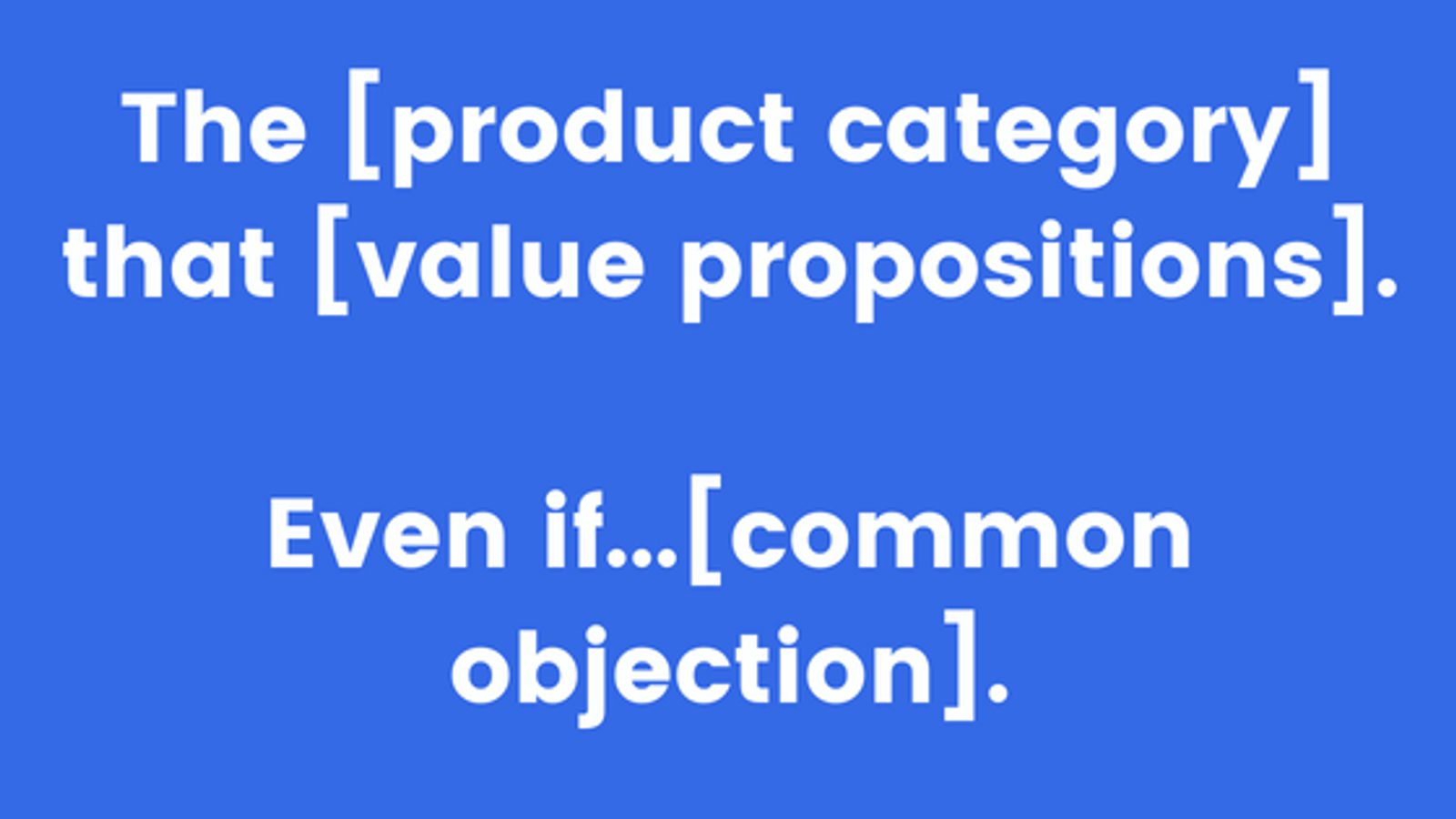
A simple formula to be more persuasive
What does this persuasion tactic look like in action?
- The exercise program helps you lose weight...even if you don’t have hours to spend at the gym.
- The marketing automation platform that grows your business...even if you don’t know how to code.
- The leadership coaching that skyrockets your career...even if you’re afraid of public speaking.
And so on.
The specific examples aren’t important – you can use this technique even if (see what I did there?) you’re in a boring industry or sell commodity products.
What’s important is that you start addressing a person’s objections before they even have a chance to think them. Your prospect feels like you can read their mind – and that your product can actually solve their problems.
Where to use: Headlines, subheads, email copywriting, blog posts, social media.
2. “Because...”
Imagine you’re waiting in line at the Xerox machine, getting ready to make some copies. I walk up to you and ask: “Can I cut in front of you?”
What would you do?
Depending on your mood, you might have some choice words to send my way. You might politely decline. You might let me go ahead just because of how taken aback you are by the weird request.
Now imagine that I instead said this: “Can I cut in front of you because I’m in a rush?”

I'm moving too fast to make copies
Maybe your copies aren’t as urgent, or you just feel like being nice. You might not always let me cut in front, but this is better than my first (quite rude) question.
But hold on! We’re not done yet.
What if I said, “Can I cut in front of you because I need to make some copies?”
What would you do then?
I’ll let you think about it – but researchers have studied this question as well.
94% of those waiting in line let the person in a rush cut in front of them.
Shockingly, 93% let people cut them “because they needed to make some copies.”
“Because I need to make some copies” is a meaningless statement – that’s the only reason anyone ever needs to use a copy machine!
The reason for the huge jump in cutting (only 60% let themselves be cut in the first condition) is the word “because.”
The word “because” is powerful. It gives people a reason to believe what you say. Use it in your messaging to make your communication more persuasive.
Where to use: Landing pages, Facebook ads, moments where you push for the sale.
3. Unity
Imagine you walk into a job interview and discover that you grew up in the same town as your interviewer.
Now imagine that it isn’t the same town, but still the same county.
Now it’s not the same county, but still the same state.
Now it’s a different state, but you went to the same college.
Now it isn’t the same college, but you had the same major.
Now you have different majors, but you see a hat for your favorite baseball team on their desk.
Clearly, we’re getting to the point where you have less and less in common with your interviewer. But anything you can do that puts you and your interviewer in the same category – so that you are the “Us” instead of a “Them” – will help you get the job.
This persuasion technique, called “Unity” by legendary psychologist Robert Cialdini in his book Pre-Suasion, is conceptually simple – we trust people who have a shared identity.
Even if that identity is that we’re both Packers fans.
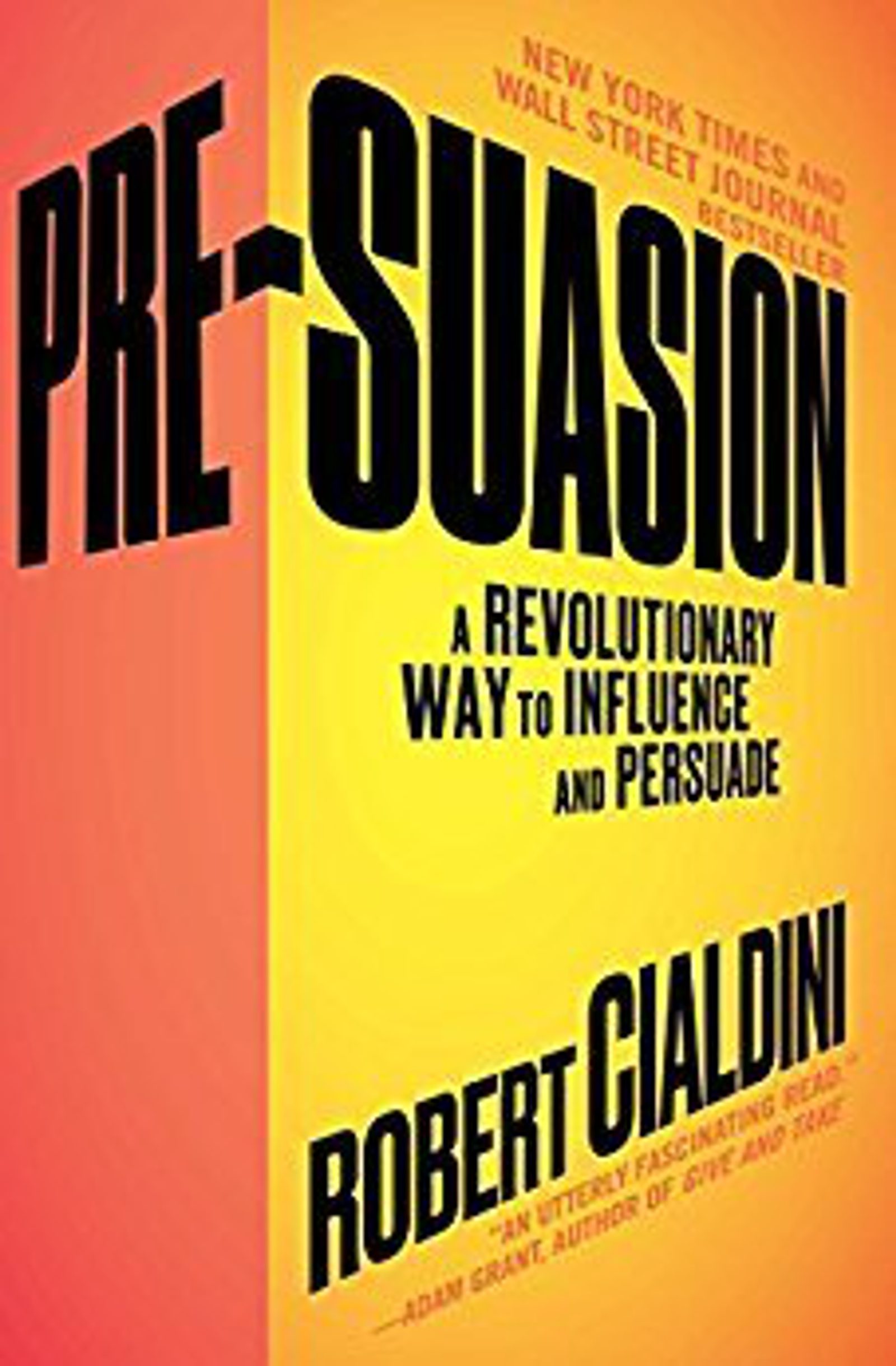
Pre-Suasion, via Amazon
Anything you can do to emphasize your connection to your audience – are you a local business? Do you support local teams? Does your founder come from a similar background? – will help your message resonate.
Where to use: Your website, home page, and about page. Any time you are introducing yourself to someone new.
4. Anticipation
In three days, you’re going to make out with a celebrity of your choice.
Or you can do it right now. Which do you pick?
Believe it or not, there’s actually research about this.
In his landmark paper “Anticipation and the Valuation of Delayed Consumption,” behavioral economist George Loewenstein asked people how much they would be willing to pay to kiss a celebrity of their choice.
Surprisingly, people were willing to pay the most money to kiss a celebrity in three days – even though “right now” was also an option.
The reason, also supported in a variety of other, less absurd studies, is anticipation. The excitement leading up to something is as important – and in some cases more important – than the thing itself.
How can you use this in your marketing?
Build excitement for your announcements. Say that something big is coming and what it will help people do – but don’t tell them what it is. Have a ramp-up time before big events.
Build excitement. Use anticipation.
Where to use: Communications before a big announcement. Social media teasers, pre-announcement emails, and other teasers.
5. Reasoning by analogy
“This nutrition plan changes the reuptake of dopamine and serotonin in the brain, ultimately impacting the regulation of appetite.”
“This diet flips a switch in your brain and makes it easier to eat healthy.”
Which is a better description?
Scientifically (if such a diet exists) it’s probably the first. But persuasively? It’s the second.

"Flipping a switch" sounds easy, so it's persuasive
When you describe your offer to your audience, it’s important to do it in terms they understand. But more than that – if you can connect your idea to a concrete metaphor or image, your idea becomes more persuasive.
Copywriter Robert Collier makes this point well in The Robert Collier Letter Book:
“The mind thinks in pictures, you know.
One good illustration is worth a thousand words. But one clear picture built up in the reader's mind by your words is worth a thousand drawings, for the reader colors that picture with his own imagination, which is more potent than all the brushes of all the world's artists…
...the secret of painting such a picture in the reader's mind is to take some familiar figure his mind can readily grasp, add one point of interest here, another there, and so on until you have built a complete word picture of what you have to offer. It is like building a house.”
He even ends with a nice little simile! “It is like building a house.”
In the diet example, the first phrase seems like a bunch of mumbo jumbo. It doesn’t paint any kind of picture, and it’s likely to leave the reader thinking “huh?”
The second uses an analogy. “Flipping a switch” is easy to understand.
Whenever you can connect your messaging to the ideas your audience already understands, you have an opportunity to get more persuasive.
Where to use: Landing pages, or anywhere where you have enough space for copywriting and need to explain a complex idea.
6. The curiosity gap
Dramatic subhead aside, the curiosity gap is important. Understanding it can be the difference between marketing that works and marketing that gets totally ignored.
Actually, scratch that. Not even ignored – “ignored” implies that noticed your marketing and chose not to care about it. This is the difference between marketing that works and marketing that no one knew existed.
The first step to effective marketing is getting attention. The second step is holding attention. The curiosity gap helps you do both.
Copywriters have used the curiosity gap for a hundred years – but the idea really became popular after Carnegie-Mellon professor George Loewenstein published his paper “The Psychology of Curiosity” in 1994.

Source: American Psychological Association
In the paper, Loewenstein presents the idea of “information-gap theory.”
The short version? We (humans) become curious when there’s a gap “between what we know and what we want to know.”
The paper, which is definitely worth a full read, lists out five things that make people curious involuntarily – in other words, five things marketers can do to create curiosity.
- A curiosity-inducing question
- A sequence of events that is left unfinished (with an unclear outcome)
- A violation of expectations
- When someone else has information we are lacking
- When we used to have information that we’ve since forgotten or lost
Curiosity gets people to keep reading. That gives you more time to convince people. If you had to choose between someone spending 30 seconds or 4 minutes with your brand, which do you think would be better?
Let’s talk headlines. Which of these three is going to get you to keep reading?
- How to earn half a million dollars a year
- How can you earn half a million dollars a year?
- Do you have the courage to earn half a million dollars a year?
The first one is basically unbelievable. It’s not particularly interesting and it doesn’t ask a question. It suggests that the writer has the information you don’t have – but there are so many “get rich quick” schemes out there that credibility is low.
The second is a little better. It asks a question, which is good. But it still doesn’t challenge expectations or do anything to convince us of credibility.
But the third…
The third is a headline used by legendary copywriter Eugene Schwartz in a mail-order advertisement for a book on investing.
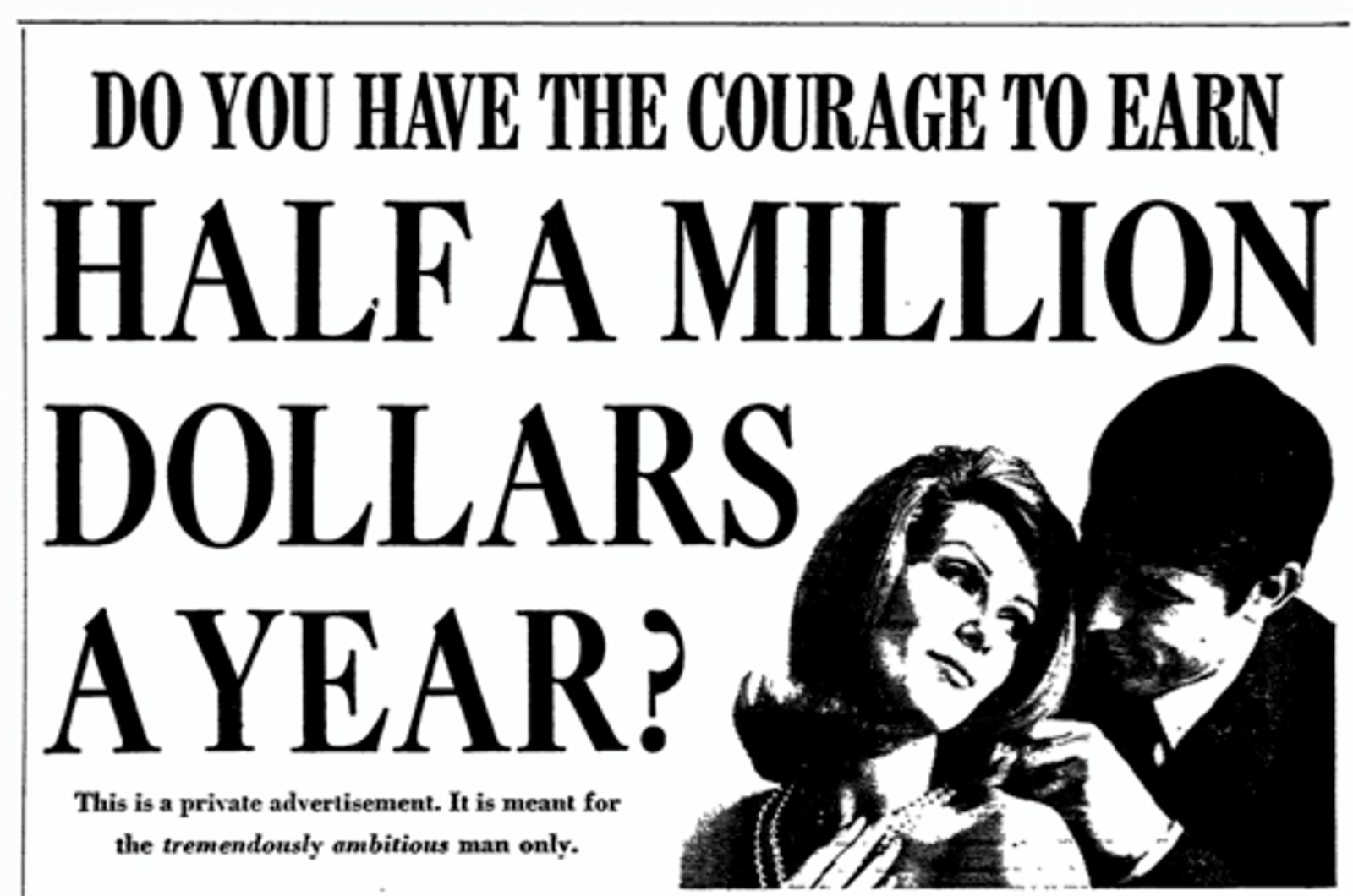
Source: Eugene Schwartz via swiped.co
Today there are more “get rich quick” schemes than ever (thanks internet), so there’s no guarantee this headline would be as effective as it was when written.
But notice how much more curiosity-inducing this headline is.
It asks a question. It implies information we’re missing. But most importantly, it violates expectations. It doesn’t start by asking us to believe we can get rich quickly. It asks if you have courage.
The natural reaction to a headline like that is to wonder: “Do I?” Or even “Psh, you bet I do!”
Either way, the headline has succeeded in grabbing attention. The reader is very likely to continue reading.
Need inspiration for ways to create a curiosity gap? Look at old-school ads and Upworthy.
Some examples:
- They laughed when I sat down at the piano, but when I started to play!
- Job hunting? How well can YOU answer the 64 toughest interview questions?
- Have you ever wondered what you would look like with a “million-dollar smile?”
- For this disabled athlete, sports are about more than play. It’s all about empowerment.
- A brilliant idea is helping anti-Trump Patriots fans feel good supporting their team.
- Her son came out. She called a gay bar for advice. The delightful convo went viral.
The first three headlines are ads by John Caples, Gary Bencivenga, and Gary Halbert (respectively). The last three, as you might have guessed, are all from Upworthy.
You want to be careful about overdoing curiosity gaps. Nobody likes clickbait – but injecting some curiosity into your marketing is a good way to grab attention.
Where to use: Blog headlines, websites, email subject lines, anywhere you add copywrite.
7. Foot-in-the-door technique
In his autobiography, Benjamin Franklin wrote that "He that has once done you a kindness will be more ready to do you another, than he whom you yourself have obliged."

Source: Amazon
He expands on the quote by telling a story about one of his legislative rivals:
“Having heard that he had in his library a certain very scarce and curious book, I wrote a note to him, expressing my desire of perusing that book, and requesting he would do me the favour of lending it to me for a few days.
He sent it immediately, and I return'd it in about a week with another note, expressing strongly my sense of the favour.
When we next met in the House, he spoke to me (which he had never done before), and with great civility; and he ever after manifested a readiness to serve me on all occasions, so that we became great friends, and our friendship continued to his death.”
This observation of Franklin’s has been called the “Ben Franklin effect,” and was the inspiration for a series of psychology studies that led to the discovery of the “foot-in-the-door technique.” Or FITD for short.
FITD was first studied by Stanford psychologists Jonathan Freedman and Scott Fraser in 1966. Freedman and Fraser wanted to test Franklin’s idea: that someone will agree to a larger request after they have first agreed to a smaller request.
The researchers called households in California. For some households, they asked if the people would mind a large, obtrusive road sign being planted in their front yard. Unsurprisingly, this was not a popular idea.
For other households, however, they first asked whether the house would be willing to display a much smaller, unobtrusive sign. This sign was quite unobjectionable, so many people said yes.
The interesting part? When houses displaying the small sign were asked if they were willing to display the big, ugly sign, more said yes.
Someone who has agreed to a small request is more likely to agree to a large request later. That’s the foot-in-the-door technique.
Where to use: Email nurture flows, tripwire emails, coupon offers, lead magnets, quizzes, and other moments at the beginning of the funnel.
8. Door-in-the-face technique
The foot-in-the-door technique gets more people to agree to a large request by first asking a small request.
What if you did it the other way around?
Amusingly named the “door-in-the-face technique” asking an excessively large request (which gets declined) before a more reasonable request makes people more likely to agree with the reasonable request.

*Slam!* "Owww..."
This phenomenon was first studied in research led by Robert Cialdini (who you’ll hear more about in a moment).
In the classic study, researchers asked people to mentor juvenile delinquents two hours a week for two years. Unsurprisingly, not many people agreed to do that. Would you?
Some people were then asked if they would be willing to help bring the juvenile delinquents to the zoo, a one-day task.
Does making a large request before a small request actually work?
People who were only asked to chaperone the day trip said yes 17% of the time. But people who were first asked to mentor delinquents for 2 years said yes to the smaller request 50% of the time.
The door-in-the-face technique is powerful. How can you use it for marketing?
Downsells!
If you’ve ever tried to sell a high-ticket item and failed, follow up with a smaller ask. You could sell a lower-priced item and see a boost in sales. Or you could simply ask non-buyers to fill out a survey – which gives you more information for the next time you sell to them.
Where to use: Sales calls. This is hard to use in digital marketing without turning people off.
9. Reciprocity
This is it. We’ve reached the Cialdini section of this article.
Robert Cialdini is a legendary social psychologist. In the world of social psychology he broke ground through his research on norms. In the world of business, he broke onto the scene with the publication of his landmark book Influence: The Psychology of Persuasion.
Influence lays out six principles of persuasion. Let’s start with reciprocity.
Imagine you’re out at a restaurant. The bill comes with a mint for each member of your party – but just when the server is about to leave, he reaches into his pouch for an extra mint to leave behind. Then gives you a sly wink.
How would that affect your tip?

Would you fill-up the tip jar?
Research from Cornell University found that tips went up by about 17%.
The social norm of reciprocity is both powerful and simple. It states that we are more likely to do things for people after they have done things for us.
When the server sneaks you an extra piece of candy, he’s being nice to you. So you in turn feel the urge to be nice to him.
Cialdini proposed that reciprocity is the power behind the door-in-the-face technique. After someone says no to a large request, you follow up with a small request. Because you’ve made a concession, the person you ask feels like they should also make a concession – by changing their no to a yes.
Opportunities to use reciprocity are everywhere in marketing. Lead magnets. Free consultations. Discounts.
“Start by adding value” is common advice in marketing – and it works because of the norm of reciprocity.
Where to use: Lead magnets, gated content, opt-in offers, cold outreach, consulting, demos, trials, and any other offer that starts an interaction.
10. Liking
“I understand. You found paradise in America, had a good trade, made a good living. The police protected you, and there were courts of law. And you didn't need a friend like me. But uh, now you come to me and you say – 'Don Corleone give me justice.'
But you don't ask with respect. You don't offer friendship. You don't even think to call me Godfather. Instead, you come into my house on the day my daughter is to be married, and you ask me to do murder, for money.”
– Don Vito Corleone, The Godfather
Would you rather buy from a friend or an enemy?
That’s probably an unfair question, so let’s ask a different one. Would you rather buy from an acquaintance you like or a stranger that makes you feel slimy?
The principle of liking, another of Cialdini’s, is also simple – we are more likely to be persuaded by people we like.
This is the mistake Bonasera made in soliciting Don Corleone. When Bonasera comes offering money for murder, the Godfather is uninterested.
He has money. He has power. He has no interest in assisting people who are not his friends.

Source: IMDB
Granted – the type of friendship Don Corleone offers is not quite the same as the type of friendship that we typically see today in business.
But the principle behind it remains.
As any salesperson knows, it’s easier to make a sale when your prospect likes you.
As anyone knows, it is easier to hire or contract someone recommended by a friend – and you are more likely to recommend the services of people you like.
In your marketing, strive to connect with your audience. Make your marketing come from real people – people connect with other people more than brands. Show the unique personality of your team.
Show your audience how you are like them. Demonstrate that you understand them. Be friendly and positive. Build liking and you will also build your business.
Where to use: Everywhere! Be likable.
11. Scarcity
Someone who is definitely not a psychology researcher hands you 5 different Hershey’s Kisses: milk chocolate, dark chocolate, crème, caramel, and almond. Which one do you like best?
Me? I’m all about that dark chocolate. But if you don’t have a strong preference for one type of chocolate, you might discover something surprising—the last chocolate tastes best.
That’s what researchers at the University of Michigan discovered when they ran this experiment on unsuspecting students.
The researchers handed the chocolates to students one at a time, in random order. When the students were told “Here is your last chocolate” instead of “Here is your next chocolate” (thereby making them aware that this was the end of the delicious experiment) they actually rated the last chocolate as tasting better.
Note: preference for any particular type of chocolate is controlled for by the random order. But no matter what type of chocolate was presented, the last chocolate tasted best.
This is scarcity in action.
When we know that something is rare or hard to come by, we value it more.
It’s why the last cookie is more valuable than the second-to-last cookie. It’s why you might find yourself pausing your road trip to see the World’s Largest Brick. And it’s part of why people in this study liked the last chocolate best (endings may also have a power of their own).

The World's Largest Brick, via Roadside America
Scarcity is another of Cialdini’s principles of persuasion – but unlike some of the other principles, it isn’t hard to see how you can use scarcity in your marketing.
When you say “Hurry! Tickets are selling out quickly,” you’re using scarcity.
When you say “Only 3 left in stock!” you’re using scarcity.
When Nintendo releases a hugely popular console (like the Wii, the NES classic, or the Switch) without creating enough inventory to meet demand, it’s creating more demand—through scarcity.
Scarcity is a powerful persuasion trigger. Anything you can do to remind people that your offer is rare and unique and hard to come by is powerfully persuasive.
Where to use: Countdown timers, landing pages, email subject lines, any place where you genuinely have limited stock/tickets/time and need to compel someone to action.
12. Authority
“Trust me. I’m a doctor.”
Thus spoke Dr. Dre. In his Dr. Pepper commercials, Dr. Dre leaned on his stage name to lend authority to his endorsement of Dr. Pepper.
Obviously, this is a joke. But what makes the joke funny is that it plays on a truth—people trust doctors because doctors are authority figures.
Authority is another of Cialdini’s principles of persuasion. Its influence was most powerfully demonstrated in Stanley Milgram's famous shock experiment, in which ordinary people demonstrated a willingness to give lethal shocks to a fellow “participant.”
In the experiment, participants were told to administer electric shocks of increasing intensity when their experimental partner (actually a Confederate, who was not getting shocked at all) got a quiz answer incorrect.

Participants were willing to administer lethal shocks
Many of the participants were clearly uncomfortable. Several asked the experimenters to stop, to which the researchers would reply:
- Please continue.
- The experiment requires you to continue.
- It is absolutely essential that you continue.
- You have no other choice but to continue.
So they did. Ultimately delivering shocks with lethal voltage.
This experiment has since been replicated, and the phenomenon of authority has been studied in other contexts. Expertise, badges, and uniforms – symbols of authority have an effect on beliefs and obedience.
The takeaway for marketers is that people trust authority figures. If 4 out of 5 dentists agree, who are you to say otherwise?
When you can bring in expert advocates or authoritative statistics to support your marketing messages, you can increase the persuasiveness of your message.
Where to use: It generally helps, but this is especially useful when making expert or scientific claims.
13. Commitment & Consistency
Why does the foot-in-the-door technique work?
If you think about it, it doesn’t really make sense. A past action has no real impact on an unrelated future action—or at least, it shouldn’t.
And yet it does. The answer is the principle of consistency and commitment.
Another of Cialdini’s principles, this states that people want to behave in ways that are consistent with their beliefs and past behavior.
People use their sense of self and their beliefs to make decisions. When we make decisions (like agreeing to post a small sign about traffic safety in your yard), we think that we do it because we believe in the cause.
But changing your self-concept, the way you think about yourself, it mentally taxing. So when we have an opportunity to behave in a way that’s consistent with our self-concepts (like posting a large, ugly sign about traffic safety in your yard), we take it.
After all, we’re the kind of person that cares about traffic safety. Right?
A lot of everyday behaviors can be explained by consistency and commitment.
When you go to a concert you aren’t sure about because you already bought tickets, that’s a commitment.
When you keep reading a book because of the little “percentage complete” tracker in the corner of your Kindle, commitment.
When you split up your e-commerce checkout page into multiple steps, you activate commitment.

If your prospects have taken steps on the way to becoming a customer, remind them of those steps to activate consistency and commitment.
Where to use: Checkout flows, re-engagement emails, abandoned cart emails, surveys, progress bars, and other places where you remind people of what they've already done.
14. Social proof
Ahh social proof.
For many of us, our first experience with social proof was the annoying question “Well if all your friends jumped off a bridge, would you do it too?”
Maybe not. But if all my friends rushed to buy a particular pair of shoes, you can bet I’d at least go in to try them on.
Social proof, or its slightly darker name “conformity,” was most famously studied by Solomon Asch in the 1950s. It is the final Cialdini persuasion principle on this list.
In the classic experiment, Asch demonstrated that normal participants were willing to give obviously, horrendously wrong answers to easy questions—if everyone else in the room had given those same answers first.
In a less dark reading of social proof, it makes sense that we would trust endorsements from our peers. Brands have an incentive to represent themselves well. Our friends—unless they’ve been sucked into a pyramid scheme—have no incentive to recommend particular brands.
Social proof is everywhere in marketing. Testimonials, 5-star reviews, and even the number of users or customers (think “1 million customers served”) are examples of social proof.
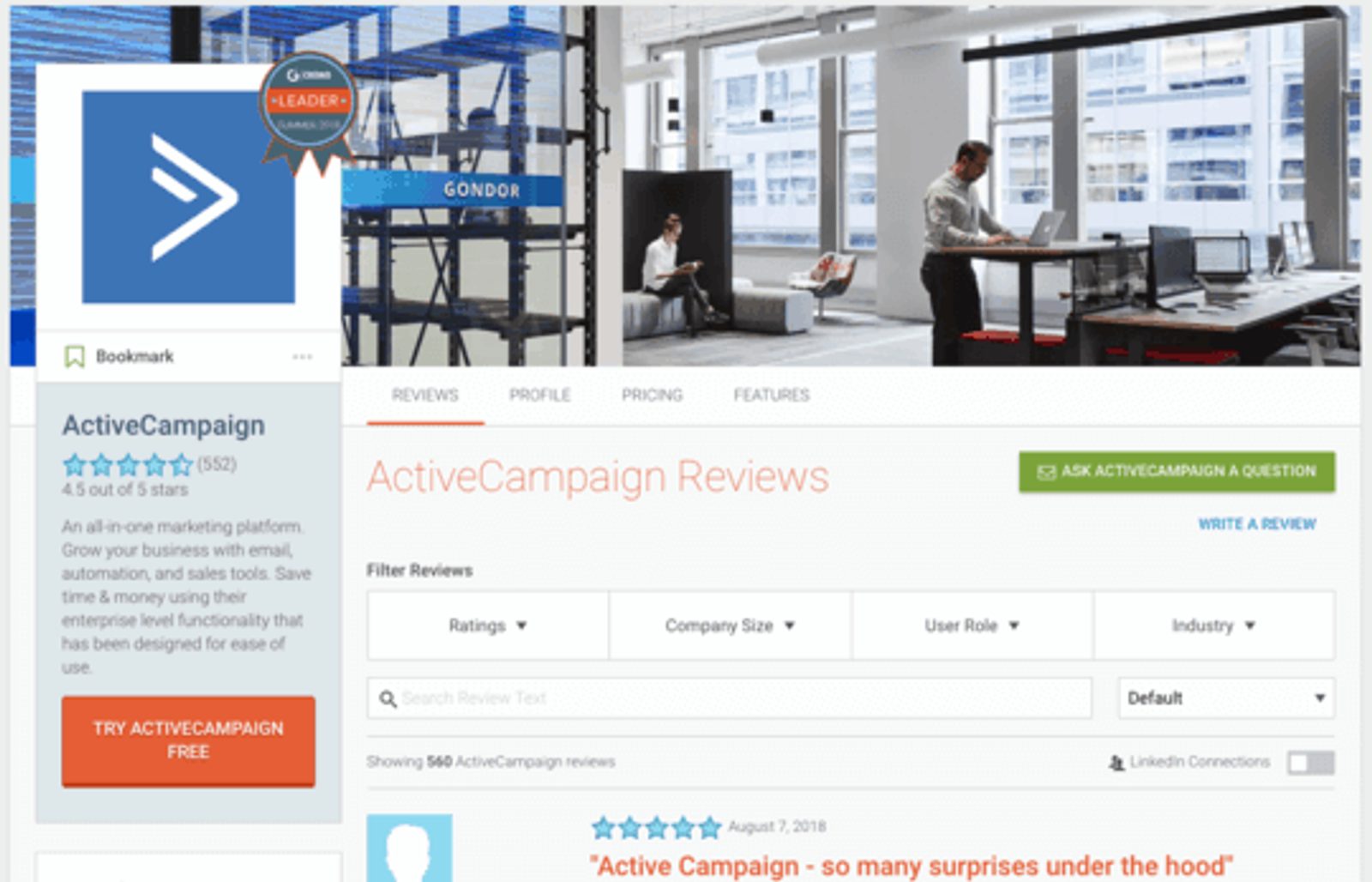
Social proof is why review sites are so popular
Where to use: It generally helps, but especially after a big claim. On your website and in case studies are common uses. You can quote a customer when making the claim yourself would be too outrageous.
15. Urgency
“Available for a limited time.”
Whenever you sell anything to anyone, there’s a critical belief you need to overcome: “I can always do this tomorrow.”
“Tomorrow” is a conversion killer. If your prospect believes that they can always put off taking your offer...they will!
Urgency is in some ways a subset of scarcity—but the urgency is specifically related to time. When you see a countdown timer on a sales page, or when an abandoned cart email says you have 2 days to complete your order, that’s urgency.
Creating time restrictions for a product launch or sale is one of the ways you can overcome “tomorrow” and get people to take action today.
Deadlines motivate us to take action, which is exactly what you want from your prospects.
You want to be careful overdoing urgency—if every offer that comes from your company feels like “buy by Friday or lose this opportunity forever,” your brand is going to suffer. Consumers don’t care for urgency when it feels manipulative.
But used strategically, with the right offer, urgency is a great way to boost your sales.
Where to use: Countdown timers, landing pages, email subject lines, any place where you genuinely have limited stock/tickets/time and need to compel someone to action.
16. Loss aversion
Would you rather get $10, or avoid losing $10?
Loss aversion is one of the most famous cognitive biases and was discovered as part of groundbreaking psychology research by Daniel Kahneman and Amos Tversky.
Here’s the scenario that Tversky and Kahneman presented in a 1981 study.
“Imagine that the U.S. is preparing for the outbreak of an unusual Asian disease, which is expected to kill 600 people. Two alternative programs to combat the disease have been proposed. Assume that the exact scientific estimate of the consequences of the programs are as follows:
- If Program A is adopted, 200 people will be saved.
- If Program B is adopted, there is a 1/3 probability that 600 people will be saved, and 2/3 probability that no people will be saved.
Which of the two programs would you favor?”
Think about that for a second while I show you the options shown to the other group of participants in the experiment.
“Assume that the exact scientific estimate of the consequences of the programs are as follows:
- If Program C is adopted 400 people will die.
- If Program D is adopted there is a 1/3 probability that nobody will die, and 2/3 probability that 600 people will die.
Which of the two programs would you favor?”
People in the first group preferred Program A, which guaranteed to save 200 people.
But people in the second group chose Program D. Even though, by the numbers, that program is exactly the same as Program B.
Loss aversion makes people shy away from sure losses and seek out sure successes.
How can marketers use this idea?
Well, a lot of them use it poorly. Check out these emails from Levi’s.
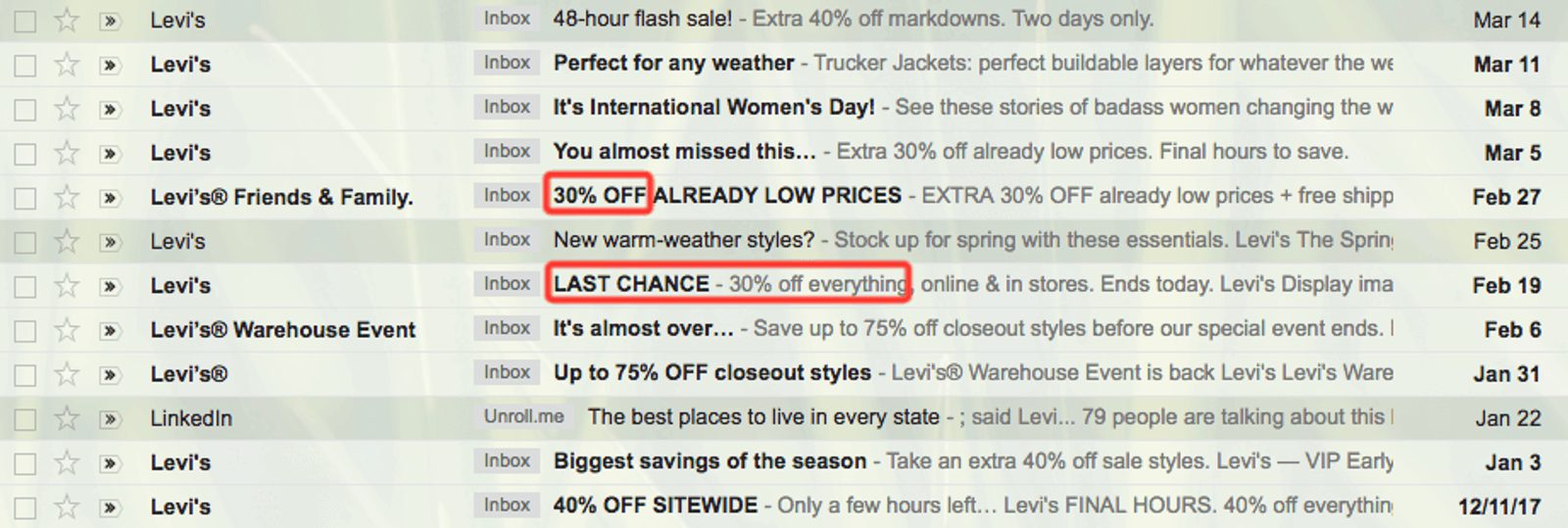
Is it really my last chance?
I love the jeans I get from Levi’s. I don’t care for the emails.
Levi’s is trying to use loss aversion to compel me to take action. ACT NOW BEFORE YOU LOSE THIS OPPORTUNITY FOREVER. That’s what most loss aversion marketing is like.
The problem is...there’s no real loss here. Oh no, I’ll have to wait a whole EIGHT DAYS before there’s another sale!
Loss aversion can be powerful, and you can activate it using scarcity and urgency.
But there’s another side of loss aversion that marketers don’t seem to talk about as much. The aversion to spending money.
Kahneman and Tversky’s research on loss aversion and “prospect theory” shows that people don’t like uncertainty. In situations where there’s a risk, people tend to prefer safe options.
Any time you spend money, you take a risk.
You risk the product not being what you expect. You risk it being low quality. You risk it not being able to solve your problem.
And the more important the product—the more important the problem it solves—the higher the risk.
Marketers can mix loss aversion with scarcity and urgency. But they can also understand the loss aversion inherent to any purchase—and try to reduce uncertainty.
How?
- Great messaging that makes the benefits of your product clear. People need to be able to tell what you actually do (this problem is more common than you think).
- Authority and social proof. If you are an authority, say so. Better yet, have your previous customers talk about how great you are.
- Offer a guarantee. Guarantees remove risk. When return policies are good, more customers will try out your product (you’ll find that the increase in customers more than makes up for any refunds).
Where to use: When you would use scarcity or urgency, but also when using future pacing (see next) and after establishing a strong benefit.
17. Future pacing
What are the 5-inch and 5-mile benefits of your offer?
One of the challenges of marketing is getting people to focus on long-term results. Outside of products that fill immediate needs, a lot of products have long-term benefits.
And even if your product is focused on solving immediate pain points—the more you can get people to imagine themselves using your product, the more likely they are to be interested.
Enter future pacing.
If you do future pacing well, what happens?
- Imagine, 4 days from now, you use future pacing for the first time and instantly start converting more customers.
- 2 months from now, future pacing is second nature. You can use it casually in conversation, and people instantly understand the value that you offer. Becoming a customer is a no-brainer.
- A year from now, your business is thriving. Your sales have skyrocketed because people really understand and appreciate what you do.
That’s future pacing—picking a few points of time in the future and sharing the benefits that your prospects will enjoy at each point.
In short:
- Begin with a phrase like “imagine” or “picture yourself”
- Follow up with a specific time in the future, beginning with the near future
- Share a specific benefit
- Repeat with a time farther in the future
Why does this work?
First, future pacing works because it gets people to picture themselves using your product. When your prospects can see themselves using what you offer, they can more easily see the value.
Second, future pacing works because it starts in the immediate future. Humans, as a whole, are bad at long-term thinking. Future pacing starts out by solving an immediate pain.
And finally, future pacing works because it ends on an enormous, believable benefit.
If you start with the benefits that people experience months or years down the line, they’ll tune you out. “Yeah sure, whatever,” will be their reaction.
They won’t believe you.
But when you use future pacing, the benefits are believable. Because you’ve painted a picture of each step along the way, it’s easy for people to see how the big results are possible.
The best part?
Once people see that big results are possible in the long term, they associate your product with those results in the short term. That’s the power of future pacing.
Where to use: Landing pages, paid ads (especially Facebook Ads), YouTube ads, and sales calls.
18. The Zeigarnik Effect
Your server at a restaurant has an uncanny memory.
For about 45 minutes.
The Zeigarnik Effect was discovered by the psychologist Bluma Zeigarnik, after an interesting observation about the memory of servers in restaurants.

Bluma Zeigarnik, via Wikipedia
As the story goes, restaurant servers have excellent memories—but only for orders that have yet to be delivered. Once a meal is on the plate, servers forget about it entirely.
Why?
Because people have a better memory for the unfinished.
When a task or story is unfinished, it sticks in your memory. Your brain doesn’t want to forget it, because you are still likely to need that information.
But as soon as the task is finished, that information is no longer useful to you. So it goes away.
What does that mean for marketing?
The Zeigarnik Effect is one powerful way to create curiosity gaps. Instead of stating information outright, you can tell unfinished stories that build anticipation.
Where to use: Landing pages and videos, especially paid video ads on Facebook, Instagram, or YouTube.
19. High-activation emotions
Have you ever heard someone say “People justify their purchases with logic, but they make decisions based on emotions?”
It’s true. At least, some of the time. But which emotions are the most important?
When Wharton professor Jonah Berger analyzed 7,000 articles from The New York Times, he found that some emotions led to more sharing than others.
Specifically, he found that “high-activation” emotions are more likely to lead to action.
- Amusement and awe are high-activation positive emotions. Both increase sharing.
- Anger is a high-activation emotion. Even though it’s negative, it increases sharing.
- Sadness is a low-activation, negative emotion. Sad content is shared less.
Does that mean that you’ll get more clicks if you make people angry? Not necessarily. If anger doesn’t match up well with your offer, it likely won’t drive people to buy from you. And if all you do is spout anger, you may wind up degrading your brand.
But activating strong emotions right before a call to action could be a good way to get people to take that final step.
Where to use: Everywhere, but especially to grab attention (social media, advertising) or close a sale (landing pages).
20. “Purple Cows”
How now brown cow? Nobody cares.
Brown cows are boring. So are black cows, and cows with those little splotches on them. You know what’s interesting? A purple cow.
That’s Seth Godin’s argument in his book Purple Cow. If you want to stand out with your marketing, you need to do something unexpected and remarkable.

Source: Amazon
There’s research to support this idea too. Things that are surprising are more likely to attract attention. And attracting attention is the first step to building a memorable message.
In their excellent book Made to Stick, brothers Chip and Dan Heath lay out a process for creating memorable, persuasive messages.
“A good process for making your ideas stickier is:
- Identify the central message you need to communicate—find the core;
- Figure out what is counterintuitive about the message—i.e., What are the unexpected implications of your core message? Why isn’t it already happening naturally?
- Communicate your message in a way that breaks your audience’s guessing machines along the critical, counterintuitive dimension.
Then, once their guessing machines have failed, help them refine their machines.”
Doing something unexpected throws people for a loop and makes them pay attention to you. If you recall, unexpectedness is also one of the 5 ways to create a curiosity gap.
Where to use: Try to get this into all of your marketing.
21. The word "you"
Once you have someone’s attention, you need to keep it. How?
You can hold attention using a curiosity gap, for sure. Creating a mystery and not explaining it right away is one way to get your readers to keep reading.
But there’s another way…
A way that uses the most powerful word in the English language. One I’ve used over 200 times in this post.
The word “you.”
As Robert Cialdini highlights in his book Pre-Suasion, the word “you” is captivating. The things that hold our attention are the things that are relevant to us personally—speaking directly to your audience, in the second person, helps you keep them reading.
When you read about things that are relevant to you, you pay closer attention.
That’s why one of the most powerful copywriting techniques is to swipe words directly from your audience.
In 2017, copywriter Joel Klettke laid out what “voice of customer” copy looks like during a talk at Unbounce’s Call To Action conference.

Joel Klettke at CTA Conference, via Unbounce
Can you tell the difference?
- “Sales made simple” vs. “You hate guesswork and busywork – so we made sales less work”
- “Affordable email marketing software” vs. “The only email tool that pays for itself"
- “Breakthrough native reporting limitations” vs. “Get the reports your CRM can’t give you – without the headache it does”
When you use the exact words that your audience uses, they feel like you’re speaking to them directly—even more powerfully than when you use the word “you.”
Where to use: Everywhere. Always address your reader.
22. Anchoring and adjustment
Quick! You have 5 seconds. What’s 1 x 2 x 3 x 4 x 5 x 6 x 7 x 8?
When Kahneman and Tversky asked their participants this question, the median answer was 512.
Then they asked a different group of participants a different question. In the same 5 seconds, what’s 8 x 7 x 6 x 5 x 4 x 3 x 2 x 1?
Of course, this is the same question. But when the larger number was presented first, the median guess was 2,250.
The real answer? 40,320.
Why the difference in answers? Kahneman and Tversky had discovered “anchoring and adjustment,” a “cognitive heuristic” (thinking shortcut) that can sometimes cause wildly inaccurate estimates.
When you’re presented with two numbers, you don’t evaluate them on your own. You compare them to each other.
In other words, you get “anchored” to the first number you seen.
Where is this useful for marketers? The most obvious place is on pricing pages.
If you offer a $45 per month plan for a product or subscription, people might think it’s too expensive. But if you put it next to a $200 per month plan, it suddenly seems like a bargain.
When a car salesman starts throwing in all kinds of extra perks and bonuses, it’s because he knows that a $50-floor mat seems like a non-expense—at least, it does after someone has committed to buying a $25,000 car.
Where to use: Pricing page, sales calls, anywhere you show your price (checkout pages, the bottom of landing pages, win-back emails). Also coupons, offers, and limited-time sales.
23. Belief matching
What does parenting have in common with hostage negotiation?
It sounds like that’s the set-up to a joke, but it’s a serious question. Check this out.
- How to Talk So Kids Will Listen… is a book about parenting. It recommends beginning an interaction by empathizing with children, repeating their words back to them, and giving limited choices.
- Never Split the Difference is a book on negotiating by the FBI’s lead hostage negotiator. He recommends beginning a negotiation with “tactical empathy,” labeling the counterpart’s emotions, and repeating words back to them.
These books cover wildly different subjects, but the core of their approach is the same—meet people where they are.
Copywriters know this too, and call the concept “belief matching.”
Conversion copywriter Joanna Wiebe has written that the top 10% of any page should be focused on matching.
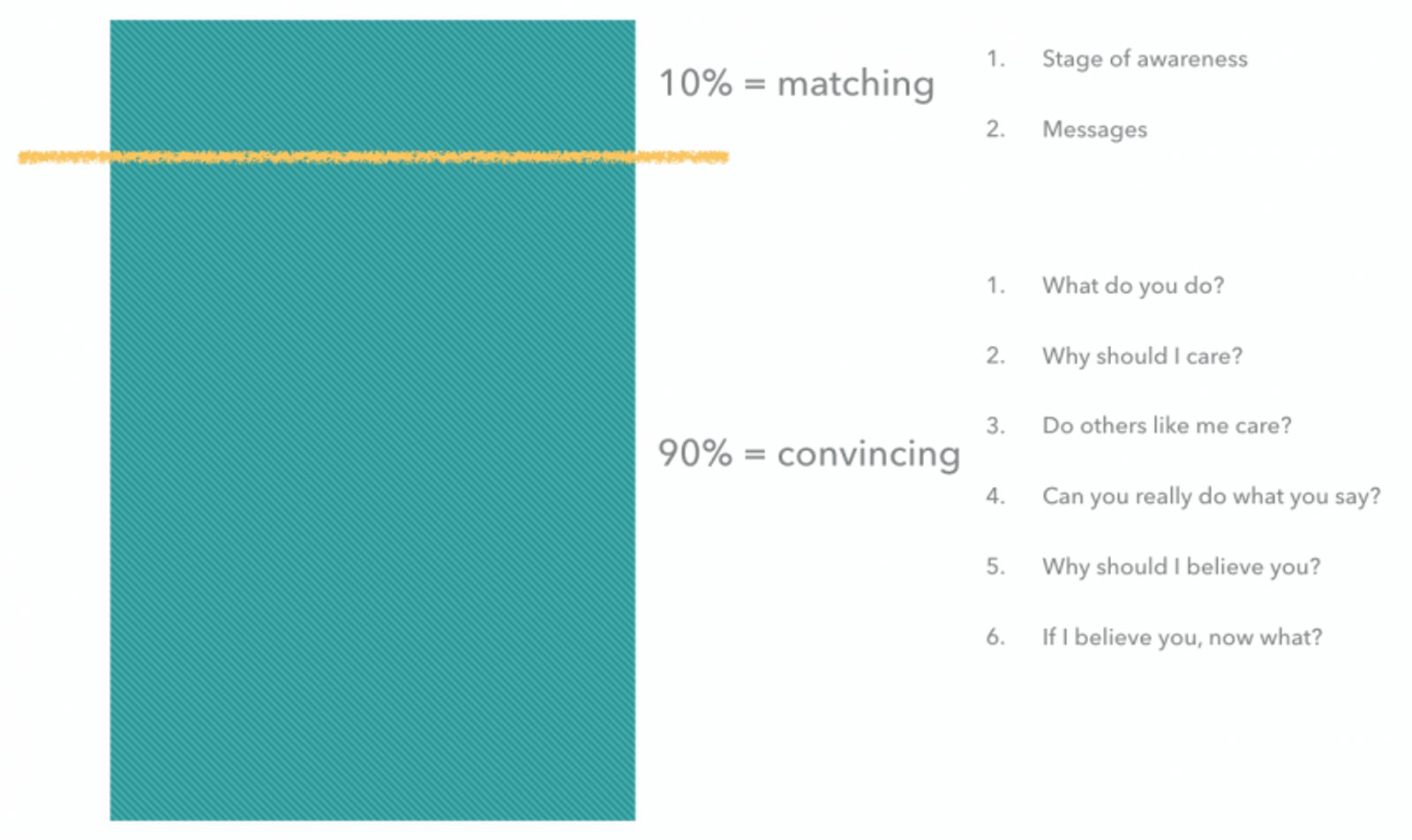
Source: Copy Hackers
One of the most popular copywriting frameworks out there is “PAS” (Problem, Agitation, Solution). When writers use PAS, they start by highlighting the reader’s problem—using the same words that the reader would use.
Why does this work?
Psychology research shows that labeling problems and emotions makes them easier to deal with. When people go through a labeling exercise, they activate more logical, less emotional areas of the brain.
As the emotional storm calms down, there’s an opportunity to challenge or change beliefs.
This approach is common to a lot of the most effective therapy techniques being used today. Cognitive-Behavioral Therapy, Dialectical Behavior Therapy, and Mindfulness Therapy all have a focus on labeling negative emotions, which makes them easier to manage.
Belief matching also works because it bypasses a psychological bias: belief perseverance.
Belief perseverance is the idea that a belief, once formed, is relatively hard to change. Even in the face of new evidence, existing beliefs are likely to persist.
In his excellent book The Righteous Mind, psychologist Jonathan Haidt points out that a lot of logical reasoning is actually caused by emotions. In studying moral beliefs, he found that people tend to have a gut emotional reaction—and then justify it with logic.
With that in mind, belief matching starts to make sense.
You can’t argue against beliefs with logic, because the beliefs don’t come from logic. As long as the underlying emotional state is still there, the brain will just throw up a new “logical” explanation.
And when it can’t come up with any more explanations, people say “I can’t explain it, that’s just how I feel.”
So how do you challenge belief perseverance? Belief matching.
Target the underlying emotions. Label them. Use the same words that your audience uses to describe their problems.
Because you understand them—because you’ve helped calm the emotional storm—they’ll be ready to listen to what you have to say.
Where to use: Everywhere, but especially cold audiences who don't know you yet.
Conclusion: Persuasion techniques for good
With great power comes great responsibility.
Understanding how people think and make decisions can help you become more persuasive. But with that understanding comes a responsibility to use it, well, responsibly.
Techniques like belief matching, used ethically, are both more effective and more empathetic than traditional marketing. Show people you understand them, and they’ll put in more effort to understand you.
Use persuasion techniques not to deceive, but to draw attention to the value that you offer.



